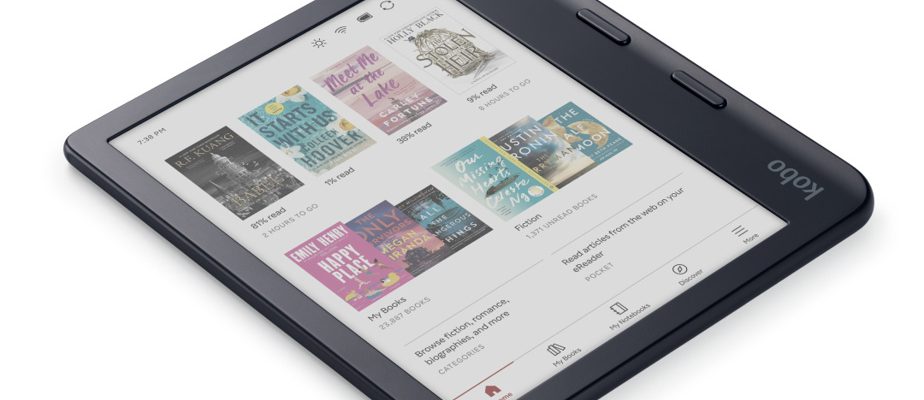For the first time in almost 14 years, Kobo is launching a color e-reader, the Libra Color, with significantly improved battery life. We won’t confuse its processor with that of an iPad and library loans are still a headache, but the evolution is notable.
WE love
In quick succession, two e-readers from Rakuten Kobo hit the market on April 30, the Toronto manufacturer purchased by a Japanese group in 2012, offering a color screen for the first time. It’s the largest, the Libra Color with a 7” screen, which we were able to test for two weeks. The Clara Color, with a 6” screen, is the cheaper version at $179.99.
The Libra, therefore, uses E Ink technology, renamed here Kaleido, which ensures electricity consumption that is far lower than the AMOLED and Retina screens of tablets and phones. Essentially, instead of refreshing the image 60 to 120 times, “e-ink” technology reconfigures the e-reader’s two million pixels just once, on each page, and keeps them in that position. Only the backlight then uses the battery.
If this little technological sleight of hand previously allowed e-readers to display a battery life of almost two months, it is clear that the Kobo products that we have tested for eight years rarely exceeded two weeks. This is an irritating observation that many readers have told us about.
Well, first good news: in two weeks and around twenty hours of reading, the battery of our Libra Color is still at 68% charge. We therefore mathematically achieve, with the minimum orange brightness that we prefer, almost six weeks of autonomy, which is more than respectable.
Now let’s talk about color. First, it absolutely changes 90% of the reading experience in our case, with most books only requiring black and white to be appreciated. This is a little extra touch, rather pleasant without being essential, added to the cover and the home menu where book suggestions are displayed.
Note that the resolution offered in color is lower, 150 ppi rather than 300 ppi in black and white. The colors are washed out and the nuances are minimal.
There’s another benefit to color: Libra Color is compatible with the Kobo Stylus 2 ($89.99), which allows you to annotate books and fill in pages of notes with built-in software. Here, indeed, the addition of color becomes more interesting for those who are fans of these styluses, which is not really our case.
The Libra Color is equipped with a “dual 2.0 GHz processor” which does an honest job, nothing more. E-readers are rather slow devices that are not designed for agile navigation, and this one respects tradition. The 32 GB storage allows you to add a staggering number of tens of thousands of e-books, but that is not the primary purpose of this generosity. This e-reader can indeed play some 100,000 audio books from the Kobo library on headphones connected via Bluetooth. The experience is satisfactory, the e-reader responds well to commands, but we much prefer to use our phone for this purpose.
Kobo obviously still has its library of 6 million books, including 1.5 million accessible with a subscription starting at $9.99 and a few hundred thousand – the exact number is not known – in French.
We note on the software side that you can now open digital books by placing them in your Dropbox or Google Drive cloud folder. This is an interesting addition when you don’t want to have the hassle of downloading a book from your computer.
The Libra Color can be accompanied by a case – a highly recommended purchase despite its cost of $44.99 – which has the task of protecting the e-reader and, above all, automatically putting it in sleep mode when you close it. A good point: after the weird design of some previous cases, which had to be removed to access the power button, the Libra Color finally has an opening in the right place.
Ah yes, the two mechanical buttons, which are now always present in new e-reader models, are appreciated and offer a more stable alternative for navigating than the touch screen.
We like less
We repeat ourselves, but it’s because the solution has still not been found: borrowing recent books from the library and reading them on your Kobo is quite a headache. Both Kobo and Adobe, designer of the Adobe Digital Edition (ADE) software that must be used, are passing the buck. You must either use an old version of ADE, or transfer your borrowed book at the same time as an old digital book from before 2018 or a PDF. Patenting that we could do without.
At $249.99, the Libra Color cannot be called affordable.
The sensitivity of the touch screen leaves something to be desired. You often have to try twice, wait for the reader to react or fall back on the mechanical buttons.
One buys ?
Because they are not totally dependent on an ecosystem like Amazon’s e-readers, we have long preferred Kobos. The two brands are practically the only ones active on the North American market. And the Livra Color is a nice improvement over Kobo’s latest model, the Sage. It is not such a spectacular development that merits abandoning its previous still functional model, but clearly a good purchase if you are part of the sect of fans of these small technological devices which basically only serve ‘to one thing, but that they do well: reading.
